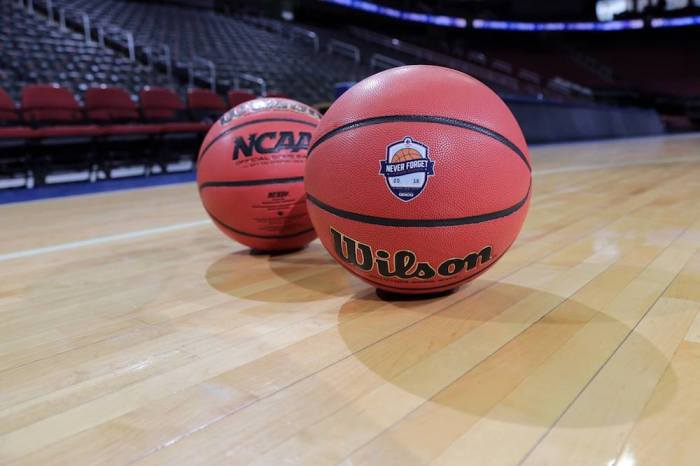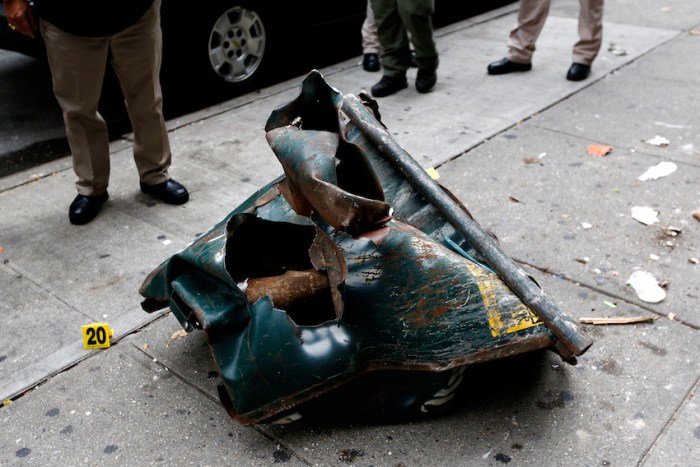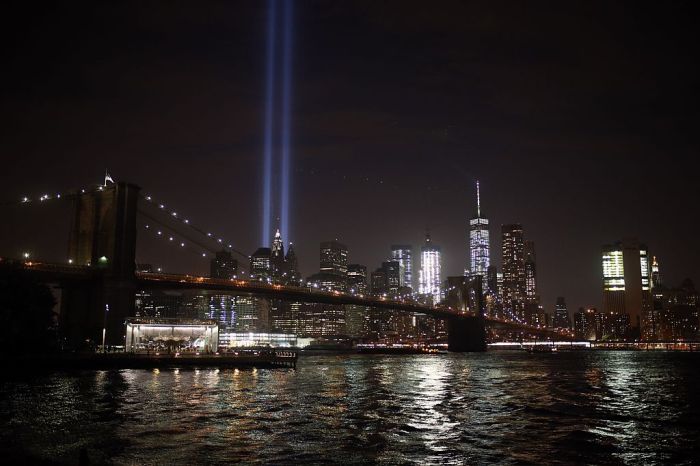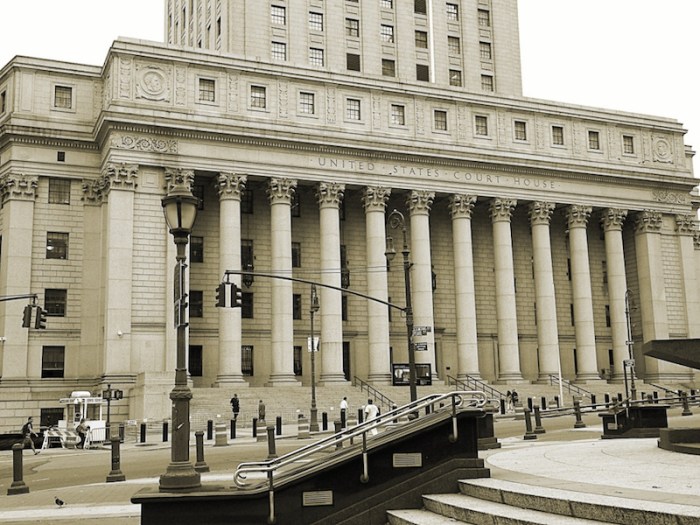“It’s so pretty here,” Victoria Smaltz of Indianapolis said as she took in the 9/11 Memorial on Thursday afternoon, a day so crystal clear that it was hard to tell where One World Trade Center ended and the sky began.
It wasn’t much different from that Tuesday morning 16 years ago today, when New York City and the world were forever changed.
“The first plane we thought was a mistake. When I went outside to bring in my sign, I saw the second plane hit,” said John Costalas, who has co-owned the Essex World Cafe at 112 Liberty St. since 1977. “When the building came down, it was very, very scary. There was one big boom, just for a couple seconds.”
Steps from the World Trade Center complex, the restaurant became a government-run medical station for five months. A large, homemade wooden sign indicating that still hangs inside. The eatery reopened two and a half years after the attacks. For more than six years, “it was very tough times,” Costalas said, adding that the neighborhood was “like a cemetery.”
Those days appear to be long gone now, as Lower Manhattan, like One World Trade Center, which opened in 2014, has truly risen like a phoenix from the ashes of Sept. 11, 2001.
“Now it’s busy, but rents are way up the last five years,” Costalas said. “We see a lot of tourists now, construction workers. The neighborhood’s alive.”
Mike Keane, an owner of the 1983-established O’Hara’s Restaurant & Pub at 120 Cedar St., agreed. A block from ground zero, O’Hara’s reopened in April 2002. “There was nobody down here at first, but the last few years have been great,” he said.
Not only are longtime local businesses thriving in the years since One WTC, its One World Observatory, the 9/11 Museum & Memorial and Oculus and Fulton Center transit hubs opened. The area has now attracted high-end retailers, hotels, celebrity chefs and much more, to become a 24/7 destination.
“Each and every year that goes by since the events of 9/11, the area has gone through a dramatic revitalization,” said Christopher Heywood, senior vice president of global communications at NYC & Company, the city’s tourism marketing agency.
Flocking to FiDi
Lower Manhattan tourism has been on a continual upswing in recent years.
In 2012, 11.7 million people visited Manhattan’s southernmost neighborhood. By 2014, that figure surged to 12.4 million and in 2016, it hit 14.8 million, according to Downtown Alliance.
With the addition of attractions like Westfield World Trade Center and Brookfield Place, the South Street Seaport rebirth and other new and on-deck destinations, the boom will likely continue.
The Alliance said – in no particular order – the Statue of Liberty, the corner of Wall and Broad streets outside the New York Stock Exchange and the 9/11 Memorial & Museum, which welcomed 10 million visitors since its 2014 opening, are among the top downtown destinations.
“It’s fun to walk in the footsteps of Alexander Hamilton and catch a glimpse of the harbor or Statue of Liberty while on my way to a hip new bar or restaurant,” said Downtown Alliance President Jessica Lappin. “It’s something you just can’t do anywhere else in the city.”
Heywood, who often travels internationally to promote New York City, looks for the new WTC when arriving home.
“There’s a great feeling of pride for this gleaming skyscraper that came to life and we rebuilt. And it’s in a thriving neighborhood – there’s a new energy.”
‘The little chapel that stood’
St. Paul’s Chapel is nothing short of a miracle.
Located across from the WTC, the chapel survived 9/11 “without a broken window or dislodged stone,” said J. Chester Johnson, a poet and parishioner of Trinity Wall Street, which operates St. Paul’s.
Johnson, who was trapped in his Wall Street office for hours on 9/11, was a member of Trinity’s vestry, or governing body, and immediately volunteered when St. Paul’s became a relief center for recovery workers.
“The hate and evilness and desire to do destruction was palpable on the pile at ground zero,” he said. “We tried to be the counterpoint to that experience. St. Paul’s was ebbing with love and care.”
The chapel provided care, food and a place of rest as workers would sleep on pews, using stuffed animals donated by a girl in Ohio as pillows. Thousands of volunteers came from all over the country, like a football coach from Alabama who collected boots for the workers.
“If they stood on the pile for 30 minutes, their boots would start to melt,” Johnson said. “He would collect those, put them in his truck, drive to New York, give the boots and volunteer for a few days.”
Johnson was so inspired by St. Paul’s survival and the humanity he saw during those difficult months that he wrote a now-famous poem, aptly entitled “St. Paul’s Chapel.” Since 2002, the poem has been on the chapel’s memento cards.
Johnson has seen firsthand how Lower Manhattan went from being closed to the public to what it is today.
“It is a wonderful memorial and rejuvenation of that experience,” he said. “That vibrancy that is now part of Manhattan life there is a nice testament to rebirth.”
Today at 4 p.m., St. Paul’s Chapel will host a Calling of the Names to honor volunteers and responders who died since the recovery, many of them from 9/11-related issues.


















